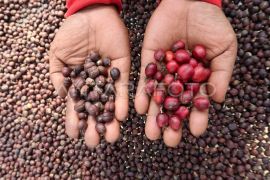In almost all cities in Indonesia, fast-food restaurants can be easily found, in contrast to those offering local cuisine, which are becoming increasingly difficult to find.
With regard to language, there has also been a shift in the use of the term masakan, earlier popular in Indonesia, though has now been replaced by the term kuliner (culinary/cuisine) drawn from English.
This poses a major challenge to the sustainability of local cuisine. Members of the younger generation -- millennials, Gen Z, and Gen Alpha -- are currently more familiar with Korean cuisines, such as kim chi, oden, topokki, and kimbab; Japanese food, such as sushi/sashimi, yakiniku, and sukiyaki; or American fast food, such as fried chicken, burgers, sandwiches, and French fries, than local cuisine.
This is a big challenge not only in preserving but also making it a driver of the local and national economy. In most regions in Indonesia, local cuisine is almost marginalized by the rise of fast food.
This phenomenon is the success of the gastrodiplomacy strategy of neighboring countries that work on cuisine as the vanguard of their economic expansion. Gastrodiplomacy is a form of culinary diplomacy conducted by the government for the public. This term was first introduced by Paul Rockower (2011).
Gastrodiplomacy is not only about introducing a country's cuisine to the community as a national branding but also about controlling the global market.
Research by Nirwandi and Awang (2014) shows that gastrodiplomacy communicates non-verbal aspects of food and culture, promotes economic growth and progressive trade, shapes consumer behavior and perceptions, and creates a wave of social conventions in the target country.
The US is aggressively expanding its economy through fast-food franchise networks across the world. Meanwhile, Japan, China, Thailand, and Vietnam are expanding through diaspora networks as non-state actors worldwide.
According to Notohamijoyo in 2015, the control of the supply chain and value chain that is carried out controls product prices, markets, and global tastes.
South Korea also carried out a massive and creative gastrodiplomacy strategy. The launch of Korea Kitchen to The World and Kimchi Diplomacy in 2002 was carried out through an integrated strategy with entertainment services such as K-pop, K-Drama, and Games.
The ginseng country succeeded in creating a global phenomenon of Korean product consumption, including cuisine, often called the Hallyu Korean Wave.
What lessons can Indonesia learn from the success stories of these countries? We need to critically analyze the fact that Indonesia does not yet have a specific strategy or roadmap for gastrodiplomacy in place.
As a country with rich biodiversity and culture, Indonesia has an array of cuisines that need to be explored further, which can strengthen the local economy and help it compete in the global market. On the other hand, the central and regional governments had yet to give special attention to strengthening the uniqueness of local cuisine in an integrated manner.
As a result, local cuisine entrepreneurs struggle alone in facing the onslaught of extraordinary cultural expansion. One example is Nasi Gandul from Pati, Central Java, which was recently designated as a National Intangible Cultural Heritage (WBTb) by the Ministry of Education, Culture, Research, and Technology in 2024.
This traditional Pati cuisine is under serious threat from the development of fast food, so it is no longer the main choice for the community. This also occurs in other areas of Indonesia.
Indonesia has a historical record of how cuisine has a strategic position and is part of the development strategy. First President of the Republic of Indonesia and Proclaimer, Ir. Soekarno, familiarly called Bung Karno, created a program to compile a recipe book from all regions of Indonesia titled "Mustika Rasa," which was published in early 1967.
For Bung Karno, Indonesian cuisine was not only a matter of the stomach but also a national identity. He always yearned for Indonesian cuisine in various state banquets, such as soto, sate, and gado-gado, and snacks, such as klepon, pukis, lemper, and bika ambon.
His exemplary work was continued by his successors who cared about preserving local cuisine, such as Dr Ir. Murdijati Gardjito, Professor of the Faculty of Agricultural Technology (FTP) UGM, who actively conducted research and penned books on the history of Indonesian cuisine, or Ibu Dinawati, who actively popularized Riau's specialties.
The next challenge is standardizing taste. Indonesian cuisine, such as soto, is so rich in flavor that it is challenging to standardize it. Promoting this dish is not an easy job. Soto dishes in each region are quite diverse, such as soto Kudus, soto Lamongan, sroto Banyumas, coto Makassar, soto Banjar, and soto Betawi.
Promoting soto requires a strong geographical approach and storytelling so that it becomes a culinary tourism attraction in each region.
Popularizing local cuisine also forms consumer tastes that require intensive and continuous education and differentiation processes. This is where the role of the government is needed to strengthen the education process, differentiation, and utilization of new media, including social media.
The success story of the Singapore Government in promoting local street food that is centered (walker center) is worth emulating. A series of promotions conducted, such as the screening of the film Crazy Rich Asian in 2018 and the presence of popular international chefs, such as Anthony Bourdain and Gordon Ramsay, helped to popularize Singaporean street food. The results of hard work and cross-stakeholder cooperation have paid off, with the acceptance of Singaporean street food into the UNESCO Representative List of the Intangible Cultural Heritage of Humanity in 2020.
Indonesia needs to focus more on strengthening the existence of local cuisine through measurable affirmative steps and involving all stakeholders, including diaspora networks abroad. We should not just be satisfied with the results of surveys by institutions that place Indonesian cuisine as global consumer favorites, such as Siomay and Pempek (Taste Atlas: 2024) or Rendang (CNN: 2021), but continue to be eroded by fast food.
*Andre Notohamijoyo is a development observer and member of Indonesia Environmental Scientists Association (IESA).
The views and opinions expressed on this page are those of the author and do not necessarily reflect the official policy or position of ANTARA News Agency.
Copyright © ANTARA 2024











